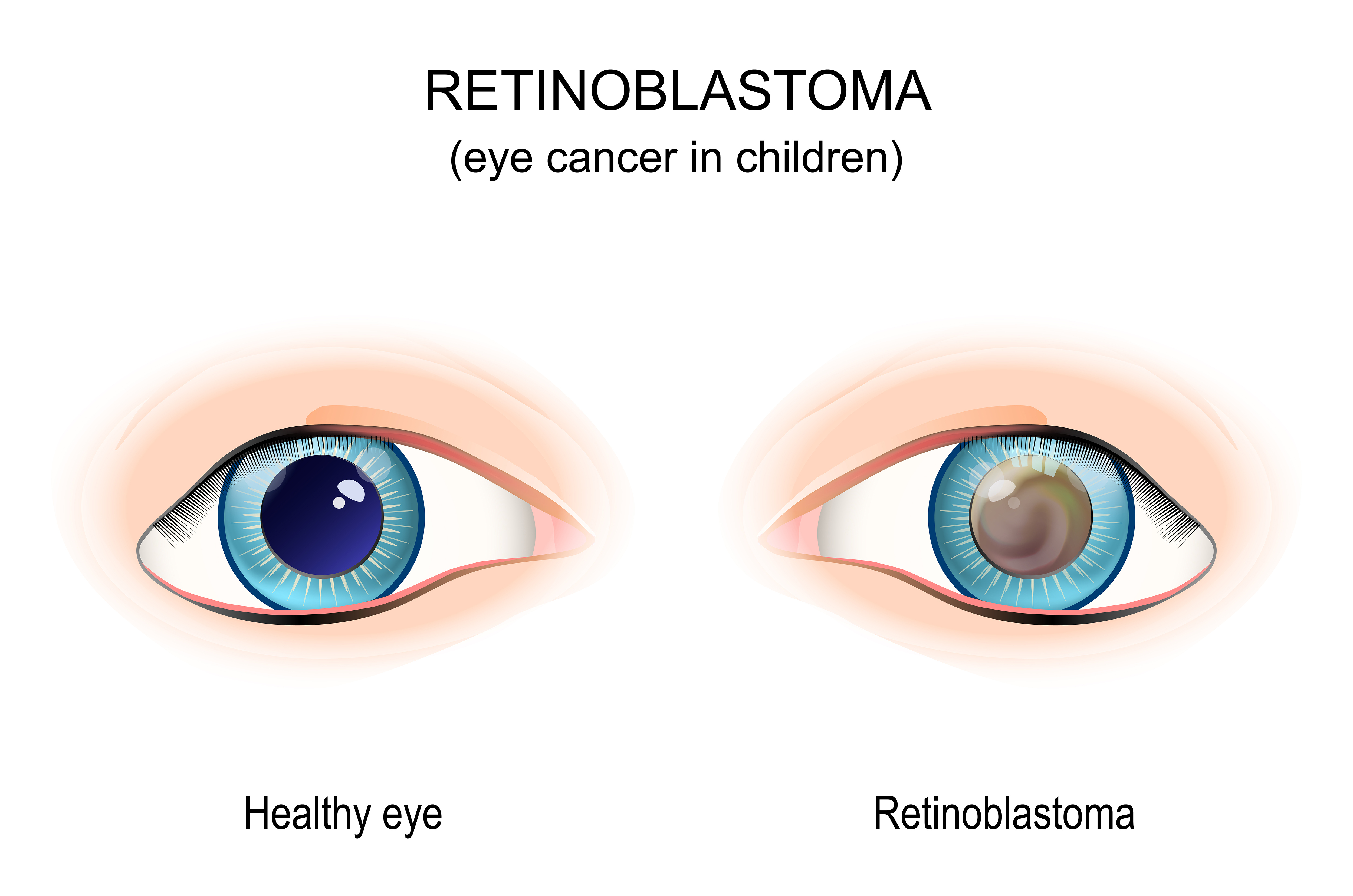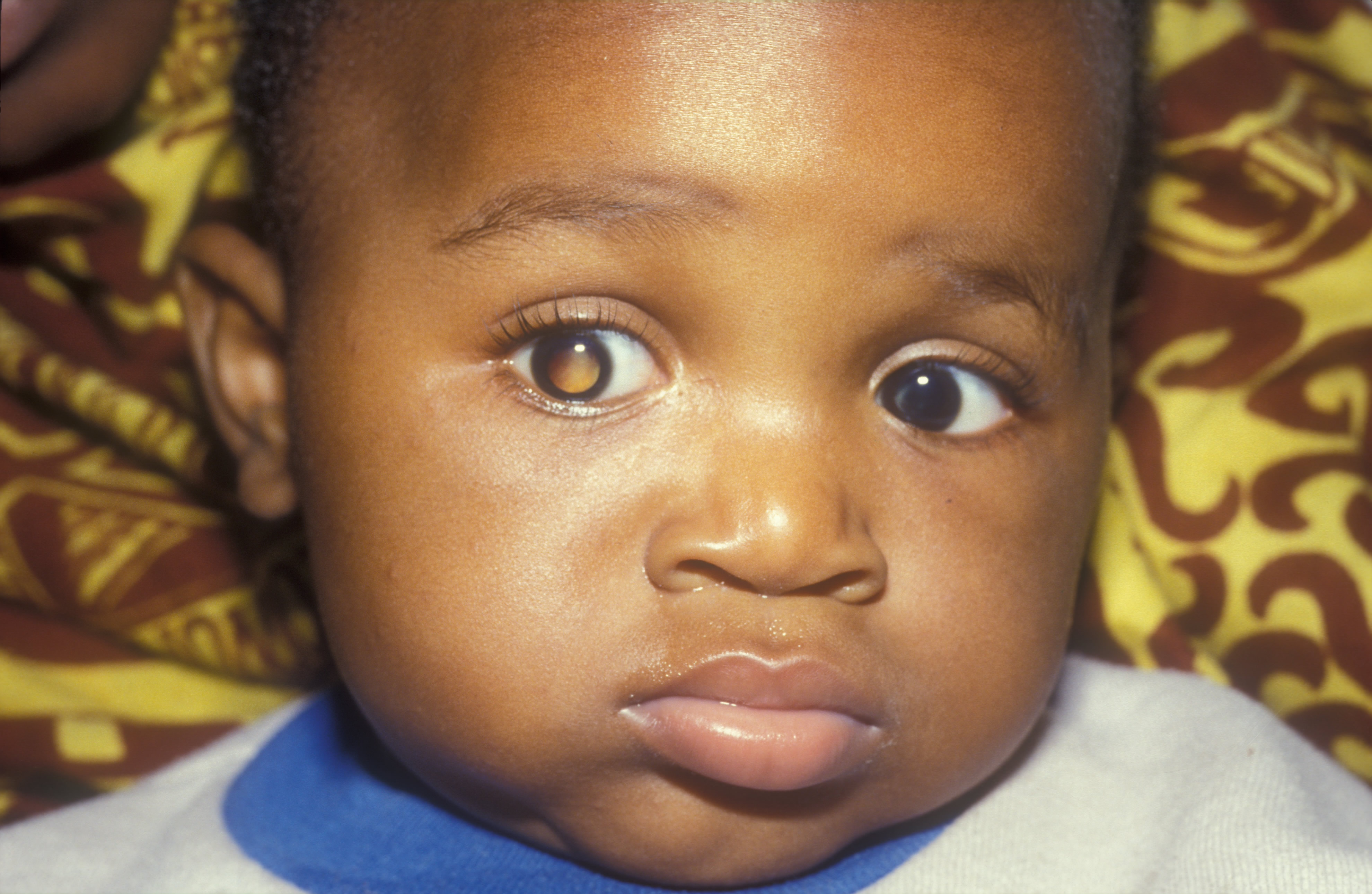Last Updated: January 14, 2025

What is retinoblastoma (RB)?
Retinoblastoma is a rare cancer of the eye that typically affects children between birth and five years of age. The retinoblastoma tumour begins in the retina, the light-sensitive layer of the eye that makes you see. Most retinoblastomas happen in one eye only, but it is possible for them to affect both eyes.1 From 1992 to 2010, there were around 11.58 cases of retinoblastoma each year for every one million Canadian children under five years old.2
What are the signs and symptoms of retinoblastoma?
Parents are usually the first to notice signs and symptoms of retinoblastoma.3 The most common signs and symptoms to look for are:
- whiteness reflected in the pupil of the eye, particularly noticeable when the pupil is dilated (leukocoria) and
- inward or outward turning of the eye (strabismus).4
Rare signs and symptoms include:
- redness and/or swelling of the eye and
- reduced vision.5
If you notice any of these symptoms in your child, you should bring them to an optometrist or get a referral to an ophthalmologist right away. These signs don't mean your child has retinoblastoma but checking them out is important.
How is retinoblastoma treated?
Treatment for retinoblastoma can include:
- cryotherapy,
- thermotherapy,
- chemotherapy,
- radiation therapy and/or
- surgery to remove the eye.
Fortunately, treatment for retinoblastoma has improved over the years, and deaths from retinoblastoma are rare. In high-income countries like Canada, the 5-year survival rate of retinoblastoma for children is 99%.6
Remember to bring your child to the optometrist for regular comprehensive eye examinations and consult your optometrist if you notice any changes in your child’s eye health or vision.

Image by Pak Sang Lee, Published in: Community Eye Health Journal Vol. 23 No. 72 MARCH 2010 www.cehjournal.org
References
- Darwich, R., Ghazawi, F. M., Rahme, E., Alghazawi, N., Burnier, J. V., Sasseville, D., ... & Litvinov, I. V. (2019). Retinoblastoma incidence trends in Canada: a national comprehensive population-based study. Journal of Pediatric Ophthalmology & Strabismus, 56(2), 124-130. Available from: https://www.researchgate.net/profile/Ivan-Litvinov/publication/331880106_Retinoblastoma_Incidence_Trends_in_Canada_A_National_Comprehensive_Population-Based_Study/links/5d3e79d3299bf1995b53d332/Retinoblastoma-Incidence-Trends-in-Canada-A-National-Comprehensive-Population-Based-Study.pdf
- Darwich, R., Ghazawi, F. M., Rahme, E., Alghazawi, N., Burnier, J. V., Sasseville, D., ... & Litvinov, I. V. (2019). Retinoblastoma incidence trends in Canada: a national comprehensive population-based study. Journal of Pediatric Ophthalmology & Strabismus, 56(2), 124-130. Available from: https://www.researchgate.net/profile/Ivan-Litvinov/publication/331880106_Retinoblastoma_Incidence_Trends_in_Canada_A_National_Comprehensive_Population-Based_Study/links/5d3e79d3299bf1995b53d332/Retinoblastoma-Incidence-Trends-in-Canada-A-National-Comprehensive-Population-Based-Study.pdf
- Gallie, B., Gronsdahl, P., Dimaras, H., Weizblit, N., Astle, W., & Bendali, N. (2009). National retinoblastoma strategy Canadian guidelines for care. Canadian Journal of Ophthalmology, 44(2). S9-S47. Available from: https://www.orpha.net/data/patho/Pro/en/retinoblastoma_canadian_guidelines_EN2009.pdf
- Gallie, B., Gronsdahl, P., Dimaras, H., Weizblit, N., Astle, W., & Bendali, N. (2009). National retinoblastoma strategy Canadian guidelines for care. Canadian Journal of Ophthalmology, 44(2). S9-S47. Available from: https://www.orpha.net/data/patho/Pro/en/retinoblastoma_canadian_guidelines_EN2009.pdf
- Gallie, B., Gronsdahl, P., Dimaras, H., Weizblit, N., Astle, W., & Bendali, N. (2009). National retinoblastoma strategy Canadian guidelines for care. Canadian Journal of Ophthalmology, 44(2). S9-S47. Available from: https://www.orpha.net/data/patho/Pro/en/retinoblastoma_canadian_guidelines_EN2009.pdf
- Fabian, I. D., Abdallah, E., Abdullahi, S. U., Abdulqader, R. A., Abdulrahaman, A. A., Abouelnaga, S., ... & Ghassemi, F. (2022). The global retinoblastoma outcome study: a prospective, cluster-based analysis of 4064 patients from 149 countries. The Lancet Global Health, 10(8), e1128-e1140. Available from: https://www.thelancet.com/journals/langlo/article/PIIS2214-109X(22)00250-9/fulltext